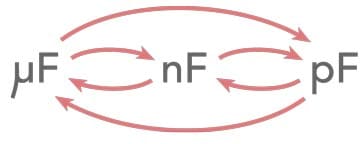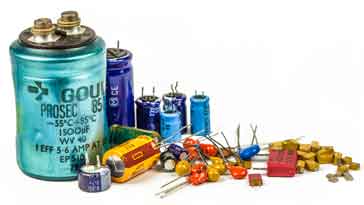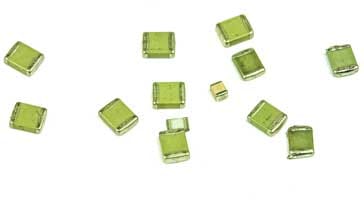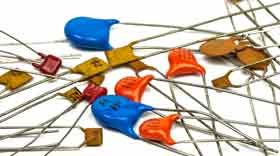Capacitor Conversion Chart & Calculator: uF to nF, pF to nF . . .
Capacitor values may be expressed in µF, nF and pF and value conversions often need to be made between them, nF to µF, nF to pF and vice versa.
Capacitance Tutorial Includes:
Capacitance
Capacitor formulas
Capacitive reactance
Parallel & series capacitors
Dielectric constant & relative permittivity
Dissipation factor, loss tangent, ESR
Capacitor conversion chart
Capacitors are a very common form of electronic component and capacitor values are generally expressed in terms of microfarads, µF (sometimes uF when a micro character is not available), nanofarads, nF and picofarads, pF.
Often there is an overlap between these multipliers. For example 0.1µF can also be expressed as 100nF, and there are many more examples of this type of notation confusion.
Also in some areas the use of nanofarad, nF is less widespread with values being expressed in fractions of a µF and large multiples of picofarads, pF. Under these circumstances it may be necessary to convert to nanofards, nF when components marked in nanofarad are available.
It can sometimes be confusing when a circuit diagram or electronic components list may mention the value in terms of picofarads for example and the listings for an electronic component distributor of electronic components store may mention it in another.
Also when undertaking electronic circuit design, it is necessary to ensure the electronic component values are specified in the current multiple of ten. It could be disastrous to be out by a factor of ten!

The capacitor conversion chart below reveals the equivalents between µF, nF and pF in an easy to use table format. Often when buying from an electronic components distributor or electronic components store, the markings of specifications may use different notations and it may be necessary to convert them.
Capacitor values can be of over 109 range, and even more as super capacitors are now being used. To prevent confusion with large numbers of zeros attached to the values of the different capacitors the common prefixes pico (10-12), nano (10-9) and micro (10-6) are widely used. When converting between these it is sometimes useful to have a capacitor conversion chart or capacitor conversion table for the different capacitor values.
A further requirement for capacitance conversion is that for some capacitor marking schemes, the actual capacitance value is given in picofarads, then requiring the value to be converted to the more usual nanofarads or microfarads is required.

Also other forms of electronic component use the same forms of multiplier. Resistors tend not to as their values are measured in Ω and higher multiples like kΩ or &MΩ but inductors are measured in Henries, and values are much smaller. Therefore milli-Henries and micro-Henries are widely used and therefore similar conversions may be required.
Capacitance conversion calculator
The capacitance value conversion calculator below provides easy conversions between values expressed in microfarads: µF, nanofarads: nF and picofarads: pF. Simple enter the value and what it is expressed in, and the value will be displayed in µF, nF and pF, as well as the value in Farads!
Capacitance Conversion Calculator
Convert electrostatic capacitance.
Convert from:
Result:
pFµF
nF
F
Capacitor conversion chart
A chart or table proving an easy translation between micro-farads,µF; nanofarads, nF, and picofarads, pF is given below. This helps reduce the confusion that can occur when having to change between the different multipliers of values.
| Capacitor Value Conversion Chart pF to nF, µ to nF, etc . . |
||
|---|---|---|
| microfarads (µF) | Nanofarads (nF) | Picofarads (pF) |
| 0.000001 | 0.001 | 1 |
| 0.00001 | 0.01 | 10 |
| 0.0001 | 0.1 | 100 |
| 0.001 | 1 | 1000 |
| 0.01 | 10 | 10000 |
| 0.1 | 100 | 100000 |
| 1 | 1000 | 1000000 |
| 10 | 10000 | 10000000 |
| 100 | 100000 | 100000000 |
This capacitor conversion chart or capacitor conversion table enables quick and easy reference of the different values given for capacitors and conversion between picofarads, nanofarads and microfarads.
Popular capacitor conversions
There are a few popular ways of writing capacitor values. Often for example a ceramic capacitor may be given as a value of 100nF. If used in circuits with electrolytic capacitors, it is often interesting to realise that this is 0.1µF. These useful conversions can help when designing, building, or maintaining circuits.
| Common Capacitor Conversions |
|---|
| 100pF = 0.1nF |
| 1000pf = 1 nF |
| 100nF = 0.1µF |
When designing circuits or using capacitors in any way, it is often useful to have these capacitor conversions in mind as values transition from picofarads to nanofarads and then nanofarads to microfarads.

A more comprehensive table of conversion factors to convert between the different values, nF to pF, µF to nF etc is given below.
| Table of conversion factors to convert between µF, nF, and pF |
|
|---|---|
| Convert | Multiply by: |
| pF to nF | 1 x 10-3 |
| pF to µF | 1 x 10-6 |
| nF to pF | 1 x 103 |
| nF to µF | 1 x 10-3 |
| µF to pF | 1 x 106 |
| µF to nF | 1 x 103 |
Capacitor conversion nomenclature
Although most modern circuits and component descriptions use the nomenclature of µF, nF and pF for detailing capacitor values, often older circuit diagrams, circuit descriptions and even the components themselves may use a host of non-standard abbreviations and it may not always be clear exactly what they mean.
The main variations for the various capacitance sub-multiples are given below:
- Micro-Farad, µF : The values for larger value capacitors like electrolytic capacitors, tantalum capacitors, and even some paper capacitors measured in micro-Farads might have been designated in uF, mfd, MFD, MF or UF. All of these refer to the value measured in µF. This terminology is normally associated with electrolytic capacitors and tantalum capacitors.
- Nano-Farad, nF: The terminology of nF or nano-Farads was not widely used before the standardisation of terminology, and therefore this submultiple did not have a variety of abbreviations. The term nanofarad has come into much greater use in recent years, although in some countries its use is not as widespread, with values being expressed in large numbers of picofarads, e.g. 1000pF for 1 nF, or fractions of a microfarad, e.g. 0.001µF, again for a nanofarad. This terminology is generally associated with ceramic capacitors, metalised film capacitors including surface mount multilayer ceramic capacitors, and even some modern silver mica capacitors.
- Pico-Farad, pF: Again a variety of abbreviations were used to indicate the value in picoFarads, pF. Terms used included: microromicroFarads, mmfd, MMFD, uff, µµF. All of these refer to values in pF. Capacitor values measured in picofarads are often used in radio frequency, RF circuits and equipment. Accordingly this terminology is used chiefly with ceramic capacitors, but it is also used for silver mica capacitors and some film capacitors.
The standardisation of terminology has assisted in the conversion of values from one submultiple to the next. It has meant that there is considerably less room for misunderstanding. It is easier converting from µF to nF and pF. This is often useful when a circuit diagram may mention a capacitor value mentioned in one way, and the electronic components distributor lists may mention it in another.

The capacitance conversion chart is very useful because different electronic component manufacturers may mark components differently, sometimes labelling as multiple of nanofarad, whereas other manufacturers may mark their equivalent capacitors as a faction of a microfarad and so forth. Obviously the electronic components distributors and electronic component stores will tend to use the manufacturers nomenclature.
Similarly circuit diagrams may mark components differently, often to keep commonality, etc. Accordingly it helps to be able to convert from picofarads to nanofarad and microfarads and vice versa. This can help identify components marked in values expressed in nanofarad when the bill of materials or parts list for the circuit may have values expressed in microfarads, µF and picofarads, pF.
Often it is helpful to be able to use a capacitance conversion calculator like the one above, but often one becomes familiar with the conversions and the popular equivalents like 1000pF is a nanofarad and 100nF is 0.1µF.
When using electronic components and undertaking electronic circuit design, these conversions quickly become second nature, but even so the capacitance conversion tables and calculators can often be very useful. These conversions are obviously useful for capacitors as well as other electronic components like inductors.
 Written by Ian Poole .
Written by Ian Poole .
Experienced electronics engineer and author.
More Basic Electronics Concepts & Tutorials:
Voltage
Current
Power
Resistance
Capacitance
Inductance
Transformers
Decibel, dB
Kirchoff's Laws
Q, quality factor
RF noise
Waveforms
Return to Basic Electronics Concepts menu . . .


